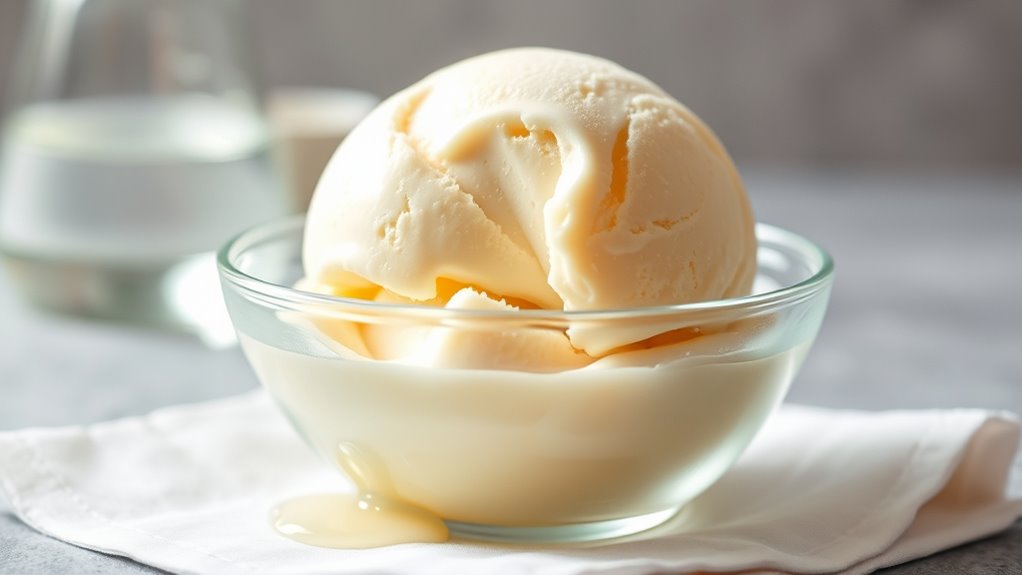Lactose-free ice cream is made by adding an enzyme called lactase to regular milk or plant-based ingredients. This enzyme breaks down lactose, the natural sugar in dairy, into simpler sugars like glucose and galactose, making it easier to digest. This process happens before the ice cream is made, so the final product tastes like traditional ice cream but doesn’t contain lactose. Keep exploring to learn more about how these tasty treats are created.
Key Takeaways
- Lactose is broken down into simpler sugars using the enzyme lactase before ice cream production.
- The enzymatic treatment converts lactose into glucose and galactose, making it digestible for lactose intolerant individuals.
- This process ensures the final ice cream contains no detectable lactose while maintaining traditional flavor and texture.
- Lactose removal can be applied to dairy milk or plant-based ingredients, depending on the product.
- The result is a creamy, lactose-free ice cream that mimics regular ice cream’s taste and indulgence.

If you’re lactose intolerant or simply looking to enjoy a dairy-free treat, lactose-free ice cream offers a delicious solution. Many brands now produce these creamy delights using dairy alternatives, making it easier than ever to indulge without discomfort. These dairy alternatives include plant-based milks like almond, coconut, cashew, soy, and oat milk. They mimic the texture and flavor of traditional ice cream, giving you a satisfying experience without the lactose. Vegan options are also widely available and appeal to those seeking cruelty-free and plant-based choices. These vegan ice creams are typically made from coconut milk, cashew cream, or other plant-based ingredients, and they often contain natural sweeteners like agave or maple syrup.
Lactose-free ice cream offers a dairy-free, creamy treat with plant-based options like almond, coconut, and cashew milk.
The process of taking the lactose out of traditional dairy involves enzymatic treatment. Manufacturers add the enzyme lactase to milk, which breaks down lactose into simpler sugars — glucose and galactose — that are easier to digest. This process occurs before the ice cream is even made, ensuring the final product is lactose-free. The result is a product that tastes just like regular ice cream but doesn’t cause the bloating, gas, or stomach upset associated with lactose intolerance. These lactose-free options can be made with cow’s milk that’s been treated or entirely plant-based ingredients, depending on the brand’s approach and target audience.
Many brands emphasize the importance of appealing to a broad audience by offering both dairy and vegan options. For those avoiding animal products, vegan lactose-free ice creams are crafted to deliver the same creamy texture and rich flavor using plant-based ingredients. They often incorporate coconut cream or cashew nuts to achieve that luscious mouthfeel. Some brands even blend the two approaches, offering lactose-free dairy products that are also suitable for vegans, providing a diverse range of choices to suit different dietary needs.
You’ll find that the popularity of lactose-free ice cream has spurred innovation in the market. With a focus on natural ingredients, lower sugar content, and sustainability, these treats are becoming more accessible and enjoyable. Whether you prefer a dairy-based lactose-free option or a vegan alternative, you can savor a variety of flavors that match or even surpass traditional ice cream. The key is knowing that these products are carefully crafted to eliminate lactose while maintaining the creamy, indulgent qualities you crave. So, whether you’re lactose intolerant, vegan, or just curious, there’s a lactose-free ice cream out there that’s worth trying.
Additionally, advancements in food technology have enabled manufacturers to improve texture and flavor profiles, making lactose-free ice creams increasingly indistinguishable from their traditional counterparts.
Frequently Asked Questions
Does Lactose-Free Ice Cream Taste Exactly Like Regular Ice Cream?
You might wonder if lactose-free ice cream tastes exactly like regular ice cream. It often has a similar dairy flavor, but some people notice subtle texture differences because the removal of lactose and added ingredients can change creaminess. While many find it close to the real deal, a few detect slight variations in taste or mouthfeel. Overall, it’s a tasty alternative, though it may not perfectly replicate the classic dairy experience.
Are All Brands of Lactose-Free Ice Cream Safe for Vegans?
Not all brands of lactose-free ice cream are vegan. Some still contain dairy ingredients, so you need to check labels carefully. If you’re seeking vegan options, look for brands that use dairy alternatives like coconut, almond, or soy milk, and verify they use vegan ingredients. Always read the ingredients list to confirm the product is free from animal-derived components, so you can enjoy your treat without compromising your vegan lifestyle.
How Long Does It Take to Produce Lactose-Free Ice Cream?
Imagine watching creamy ice cream swirl through the production process, from ingredient sourcing to final scoop. It typically takes several hours to produce lactose-free ice cream, depending on the recipe and equipment used. The process involves blending, pasteurizing, and freezing, ensuring quality and safety. Each step is carefully timed to deliver smooth, delicious results, making sure you get that perfect treat without lactose, in just a few hours.
Can Lactose-Free Ice Cream Cause Allergic Reactions?
If you have a lactose allergy, you might wonder if lactose-free ice cream could cause reactions. While it’s generally safe, some people experience cross reactivity with milk proteins, which can trigger allergic responses. Always check labels carefully, as traces of milk proteins may remain. If you’re highly sensitive, it’s best to consult your doctor before trying lactose-free options to avoid any adverse reactions.
Is Lactose Removal in Ice Cream Environmentally Sustainable?
Imagine a world where your favorite ice cream doesn’t harm the planet. Removing lactose can be environmentally sustainable if it boosts resource efficiency and reduces waste. When done responsibly, it minimizes energy use and lowers environmental impact. By choosing lactose-free options made with eco-friendly methods, you support sustainable practices. So, yes, lactose removal can be environmentally sustainable, helping you enjoy your treat while caring for the planet.
Conclusion
Now that you know how lactose-free ice cream is made, you can enjoy this dairy delight guilt-free. Think of it as a bridge over troubled waters, making everyone’s dessert dreams come true. With the lactose removed, your taste buds get the sweet escape they crave, without any discomfort. So go ahead, indulge in that creamy scoop, knowing it’s crafted with care to suit your needs. Your perfect treat is just a scoop away!










